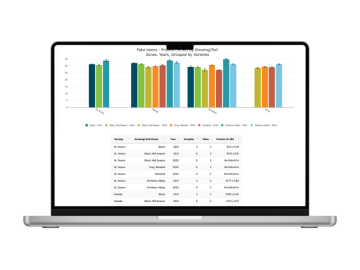
Want to mitigate climate change? Grow more pulses!
If Canada wants to get serious about addressing climate change, we can start by growing more pulses.
Nov 09, 2021

It’s COP26, and while world leaders have since left Glasgow, the conversation continues among groups as to how the world can lessen its environmental footprint while meeting the everyday needs of 7+billion citizens.
Not to oversimplify things, but if Canada wants to get serious about addressing climate change, we can start by growing more pulses. As a pulse industry, we tend to take for granted that the global population knows the inherent environmental benefits of our peas, lentils, beans, chickpeas and faba beans. They don’t, nor should they.
The reality is that consumers, businesses and governments are bombarded 24/7 by industries with hot new sustainability claims. Some of them have merit, some of them do not. Attention favours the flashy—but when you take all the flash away, Canada’s pulse sustainability story is still standing. Let’s take a quick look as to why:
1. Pulses have a low carbon footprint
We are all born with certain strengths, but the reality is some have more than others. Remember that kid who never seemed to study but always aced the test when the rest of us busted our humps for a C+? Well in the world of agricultural sustainability, that kid is a pulse. Pulses require little to no nitrogen fertilizer to grow, so sustainability comes naturally. This matters because nitrogen fertilizers, while an important and necessary part of modern agriculture, are a significant contributor to the carbon footprint of food. Want to lower that footprint? Include some pulses. Pulses also improve soil health and use water in a different, more efficient way. For the hard science, take a look here.
2. Canadian farmers know what they’re doing
You’ve heard the saying “put 3 farmers in a room and get 5 opinions”? Well, it could also be said for consumers and their definitions of ‘sustainability’. The whole world is rushing to prove sustainability cred to capitalize on this trend, but the reality is Canadian farmers have been at it for decades. Canadian farmers have adopted practices such as minimum tillage and reducing fallowing, which are practices that have been proven to sequester large amounts of atmospheric carbon into soils. This sequestration of soil carbon negates the carbon emissions of producing a pulse crop—creating a carbon neutral or even a carbon negative crop.
Canadian farmers also understand the value of rotation. Did you know that crops like wheat and barley produce higher yields and have higher protein when grown after pulses? One study has estimated that including pulses in a rotation with Canadian wheat contributed 1.3 MT of carbon emission savings, approximately 2% of the entire carbon footprint of Canadian agriculture. It isn’t one crop or the other—it is the relationship that matters. And Canadian farmers are leading by example.
TLDR: Canadian Pulses + Canadian Farmers = Healthier Environment
3. Showing the World How its done
Why just talk the talk when you can also walk the walk? Following the example of Canadian farmers, Canada’s pulse industry is leading the world in quantifying, through science, the positive impact growing and consuming pulses has on the environment. That is why Pulse Canada has developed Life Cycle Assessments (LCAs) for Canadian peas and lentils, and will soon have completed LCA’s for beans and faba beans. LCA’s will be used to populate global databases that contain all the necessary information related to the production of food products. The end result gives Canada a more credible marketing position than our competitors, letting Canadian pulse growers, processors and traders send top-quality products around the world and be rewarded by a global market willing to pay a premium for sustainability.
At Pulse Canada, we are driven by the idea that sustainability initiatives must:
- Create conditions for growers, processors, and exporters to monetize commitments being made to global environmental sustainability.
- Establish the Canadian pulse sector as a leader in providing food and ingredient solutions that decrease agriculture’s impact on climate change, effectively strengthening our global reputation and brand.
To continue our success, we need market-driven policies that foster growth of our modern agricultural sector. That is why we will continue to work alongside farmers, businesses, government and consumers to grow Canadian agriculture while lessening our impact on the environment. It’s a win-win.
Sign Up for Our Pulse Insider Newsletter
Our bi-monthly newsletter provides growers with timely, quick reads on the latest industry news and Pulse Canada’s work around the world.
Pulse Canada is the national association of growers, traders and processors of Canadian pulses, also known as lentils, dry peas, beans and chickpeas. Pulses are an essential part of a healthy and sustainable diet. Pulses and pulse ingredients can help food manufacturers improve the nutritional and functional quality of food products.



